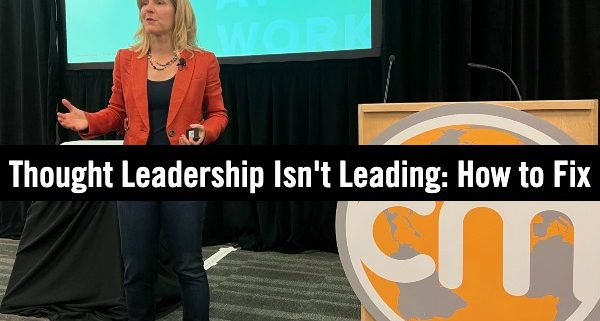Forrester: Most Thought Leadership Isn’t Thoughtful or Leading: We Need to Fix That!


Thought Leadership is a bit part of many B2B brand strategies but Lisa Gately @LisaGately, Principle Analyst at Forrester says most thought leadership isn’t thoughtful or leading, so we need to fix that.
What is thought leadership personified? Many think of Dr Fauci. There are many examples of trusted experts we rely on for information, direction and inspiration.
Lisa says most B2B content isn’t serving buyers or business goals. Technology buyer research from Forrester shows buyers are oversaturated with content, yet they are seeking trusted subject matter expertise backed by data to help them make decisions
Here’s a thought leadership:definitionL Thought leadership is an intentional exercise of knowledge skills and expertise to increase awareness elevate perception and drive preference related to key issues that audiences care about.
Lisa says most thought leadership misses the mark. It requires investment and sustained efforts to stake out big idea conversations related to a brand value proposition, core competencies, and competitive differentiation.
So what are the issues with most thought leadership?
- Sameness – fails to establish a unique point of view and attract audiences
- No prioritization – Shows lack of disciplined process or resources, with unrealistic expectations
- Self serving – Delivers inwardly focused content with low value to audiences
4 Facets of thought leadership success and the path forward
Assessing thought leadership requires a deliberate, outside-in process that examines market and audience factors before looking inward at the organizations requirements.
1. Market Context – Understand current market requirements, dynamics and competitive activity, an outside-in approach. Conduct detailed market research to understand how themes are emerging and resonating with key non-buyer influencers, and assess themes for longevity and competitive ownership. How do you do that?
- Market interest – focused research, monitor social, PR and other channels
- Theme durability – Find external SMEs motivated to partner. Filed test themes with SMEs and influencers. Develop content plans with a 12+ month view
- Competitive presence – Assess competitors content. Monitor patent filings, R&D activity and research. Partner with the competitive intelligence team.
2. Audience Insights – Focus on buyer requirements, pain points and information gaps. Thought leadership requires organizations to step into the shoes of buyers and customers and understand their most pressing concerns and interests. Again, how?
- Theme relevance – Conduct primary research with buyers, field test with customer advisory boards and partner networks. Map themes to prioritized buyer personas
- Buying process and support – Map themes to brand attribute objectives and buyer’s journey phase. Test ideas with sales and partners.
- Customer evidence – Identify accounts for advocacy efforts and prioritize customer advocates on the theme.
3. Corporate Alignment – Look inward and align with business and market strategy. Is it believable that this is who you are as a business. Considerations:
- Theme expertise – identify experts who can ideate and innovate Consider co-opting external experts.
- Corporate alignment – Assess themes with leaders from marketing, sales, and product. Understand alignment to corporate goals and test themes with employees.
- Executive support – Identify an executive sponsor
4. Organizational Readiness – Candidly assess the organizations expectations capabilities and resources. Great thought leadership often fails because the organization is unprepared to execute, whether through budget, realistic expectations or resources and competencies. Considerations:
- Time to value – Set expectations on long term multiyear investment needed.
- Budget – Align expectations with resources. Use benchmark data to build a case for resources
- Team – Plan and identify the core and extended team.
What are the benefits of a properly implemented thought leadership program? Marketplace momentum and organization value. Thought Leadership allows for stronger competitive differentiation and access to audiences ready to engage because they’ve experienced value, leading to greater brand impact and improved results.
Lisa wrapped up her presentation with these action items:
- Define – Evaluate your organization’s current thought leadership efforts for credibility and raise awareness
- Apply – Form a cross-functional thought leadership team
- Accelerate – Engage with influencer community to co-opt thought leadership activities. Tightly integrate thought leadership programs with other programs.
The post Forrester: Most Thought Leadership Isn’t Thoughtful or Leading: We Need to Fix That! appeared first on B2B Marketing Blog – TopRank®.
Did you miss our previous article…
https://www.sydneysocialmediaservices.com/?p=2420




